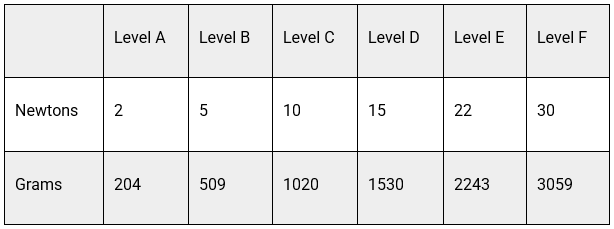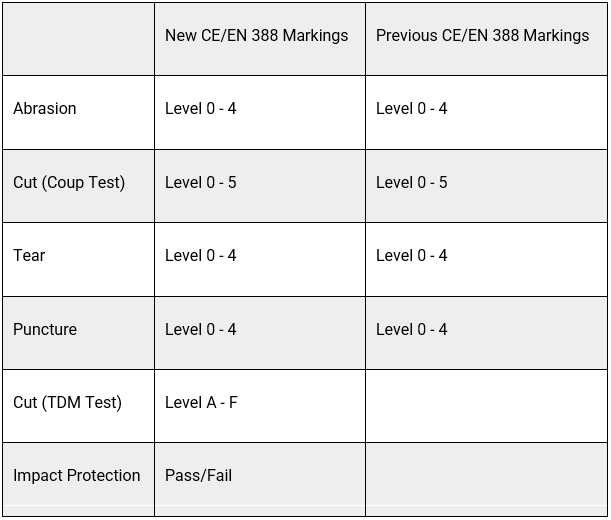Cut Resistant Glove Selection and Use – Quick Tips
Improperly handling sharp objects can create unwanted workplace hazards. Cuts, lacerations and amputations are among the potential hazards. Cut-resistant gloves can help curb hand and finger injuries when engineering and administrative controls are not enough
Occupational Safety and Health Administration (OSHA) Standards
Although there are no OSHA standards that specifically address cut-resistant gloves, 29 Code of Federal Regulations (CFR) 1910.132 and 1910.138 do apply to hand protection.
1910.132 addresses protective equipment in general:
1910.132(a): “Application. Protective equipment, including personal protective equipment for eyes, face, head, and extremities, protective clothing, respiratory devices, and protective shields and barriers, shall be provided, used, and maintained in a sanitary and reliable condition wherever it is necessary by reason of hazards of processes or environment, chemical hazards, radiological hazards, or mechanical irritants encountered in a manner capable of causing injury or impairment in the function of any part of the body through absorption, inhalation or physical contact.”
1910.138 applies specifically to hand protection:
1910.138(a): “General requirements. Employers shall select and require employees to use appropriate hand protection when employees’ hands are exposed to hazards such as those from skin absorption of harmful substances; severe cuts or lacerations; severe abrasions; punctures; chemical burns; thermal burns; and harmful temperature extremes.”
1910.138(b): “Selection. Employers shall base the selection of the appropriate hand protection on an evaluation of the performance characteristics of the hand protection relative to the task(s) to be performed, conditions present, duration of use, and the hazards and potential hazards identified.”
Characteristics, Applications and Selection
Cut-resistant gloves are designed to protect hands from direct contact with sharp edges such as glass, metal, ceramics and other materials. Cut resistance is a function of a glove’s material composition and thickness. You can increase the level of cut protection by increasing material weight (i.e., ounces per square yard); by using high-performance materials such as Dyneema®, Kevlar®, and metal mesh; or by using composite yarns made with varying combinations of stainless steel, fiberglass, synthetic and high-performance yarns.
Performance characteristics are not only affected by a material’s weight, but also by the coatings applied to the outside surface. Lighter-weight styles offer more dexterity, resulting in less hand fatigue, while their heavier counterparts generally provide more cut and abrasion protection. Coated gloves enhance grip, especially on slippery surfaces. However, some coated gloves may not be appropriate for some applications, i.e. food handling.
Industry Standards and Levels of Cut Protection
The American National Standards Institute/International Safety Equipment Association (ANSI/ISEA) 105-2016 “American National Standard for Hand Protection Classification” defines performance levels for cut resistance, blunt object puncture resistance, hypodermic needle puncture resistance and abrasion resistance. The standard provides guidance on the test methods used as well as pass/fail criteria so that you can determine what hand protection products may meet your needs.
ANSI/ISEA 105-2016 is the fourth revision of the voluntary consensus standard that was first published in 1999 and revised in 2005 and 2011. Significant changes to the cut-resistance classification determination have been made. A single test method has been selected for classification purposes (ASTM F2992-15), and the number of classification levels has been expanded to address the gap among certain levels seen in earlier versions of the standard.
The ANSI/ISEA 105-2011 standard allowed cut-resistance classifications to be determined using either ASTM F1790-97 or ASTM F1790-05, and then calculated using a newly created standardized Cut-Resistance Performance Calculator.
The European Standard EN 388, “Protective Gloves against Mechanical Risks” uses different level groupings and references two different cut test methods in the revised 2016 standard.
Cut Test Methods
When specifying cut protection gloves and accessories, it is important to understand the different test methods and standards that may be referenced:
ASTM F1790-97 (1997 test method): Original standard test method for measuring cut resistance of materials used in protective clothing. This method was developed by DuPont and is used by labs that have a Cut Protection Performance Test (CPPT) cut test machine.
ASTM F1790-05 (2005 method): This ASTM test method for measuring cut resistance is used by labs that use a Tomodynamometer (TDM) cut test machine. The later revision was harmonized with the International Standards Organization ISO 13997 cut test method. Although the method can be used for both the CPPT and TDM cut test machines, practice has been to use ASTM 1790-97 for the CPPT and ASTM 1790-05 for the TDM.
ASTM F2992-15: This ASTM test method is used by labs that use a TDM cut test machine. It measures cut resistance at a distance of 20 millimeters (mm) with a straight blade. The results are reported in grams, and they represent nine new levels, ranging from A1 to A9.These new levels replace the old five point scale and allow additional levels up to 6,000 grams for higher cut resistant materials.
EN 388-2016: The European Norm for Protective Gloves Against Mechanical Hazards. Although this revised standard continues to use the Coup test cut test machine (Coup Test) it now also references an additional cut test – the ISO 13997 (International test standard for the TDM cut test machine) cut test to address limitations caused by the Coup cut test. Use of the ISO 13997 test is a major step. Under this change, cut performance achieved using the TDM cut test machine are more aligned to the ASTM F1790-05 and ASTM F2992-15 methods.
In the ASTM F1790-97, ASTM F1790-05 and ISO 13997 test methods, the sample is cut by a straight-edge blade, under load, that moves along a straight path. The sample is cut five times each at three different loads. The data is used to determine the required load to cut through the sample at a reference distance of 25mm of blade travel when testing to ASTM F1790-97, and 20mm when testing to ASTM F1790-05 and ISO 13997. This is referred to as the rating force or cutting force. The higher the rating force, the more cut resistant the material. Neoprene rubber is used as the standard to evaluate blade sharpness.
In ASTM F2992-15, a small rectangular piece of glove material is placed on a metal mandrel of the TDM cut test device. A blade is moved across the specimen until cut-through is achieved. The device measures the distance of blade travel before cut-through as determined when the blade makes electrical contact through the specimen with the metal mandrel. The distance of blade travel is determined with different weights on the device arm holding the blade. The results are then used to determine the weight required to cut the glove material with 20mm blade travel. Using three weights across a minimum of 15 different cuts, the average of all the test scores is converted into the A1-A9 classification scale.
In the EN 388 Coup Test, a circular blade, under a fixed load, moves back and forth across the sample until cut-through is achieved. A cotton canvas fabric is used as the reference material. The reference material and test sample are cut alternately until at least five results are obtained. The cut resistance is a ratio of the number of cycles needed to cut through the test sample versus the reference material. This is referred to as the cut index. The higher the cut index, the more cut resistant the material. The Coup Test runs into problems when testing high performance fabrics because of the dulling effect the fabrics have on the blade. For materials that are shown to dull the blade during the initial test sequence in the Coup Test, EN 388-2016 / ISO 13997 states that the gloves must be tested using the TDM Test or ISO Cut Test. These methods measure cut resistance at a distance of 20mm with a straight blade. The results are reported in newtons (1 newton = 101.97 grams).
Standards Comparisons
ANSI/ISEA 105-2016 versus ANSI/ISEA 105-2011
Cut Resistant Levels in Grams

EN 388-2016 Cut Index Performance Levels (Coup Test)

EN 388-2016 / ISO 13997 Cut Resistant Levels in Newtons and Grams (TDM Test)

ANSI/ISEA 105-2016 versus EN 388-2016 / ISO 13997
Cut Resistant Levels in Grams (1 Newton = 101.97 Grams)

EN 388-2016 Markings
Although the changes to EN 388 are compulsory, there may continue to be different identification markings and performance rankings on gloves tested using the EN 388 methods until new certifications are needed. — up to a maximum of five years.

Summary
Glove manufacturers and industry standards groups have made tremendous progress in testing and measuring cut resistance. With the recent revisions of the ANSI/ISEA 105 and EN 388 standards, it is vital that you understand the different test methods in order to interpret the results, draw accurate conclusions and select the best glove for the task at hand. You must know the grams of cut resistance you need to avoid confusion between the old and new ANSI/ISEA and EN 388 standards. Manufacturers are being given a transition period to change product labeling and content to reflect the ANSI/ISEA 2016 levels. All pre-existing EN 388 certifications will remain valid until a new certification is needed (maximum of five years).
Frequently Asked Questions
Q: Do cut-resistant gloves offer good puncture resistance?
A: All cut-resistant gloves are manufactured to provide protection from a slash from sharp items like knives/blades. However, they may provide very little, if any, puncture resistance from a pointed item like a needle. If the application requires both cut and puncture resistance, some manufacturers offer gloves that provide both types of protection. Review the glove manufacturer’s specifications to help determine if a glove is rated for puncture resistance and, if so, what rating is associated with it.
Q: Should cut-resistant gloves be used to protect one from cuts from powered/mechanical equipment like powered saws and drills?
A: Manufacturers of cut-resistant gloves will not suggest the use of cut-resistant gloves for protection against powered devices. Gloves are typically tested for use with non-powered blades and sharps only. The use of a cut-resistant glove with powered equipment could potentially harm an individual. If the moving blade catches the glove, it could result in a person getting pulled into moving machinery. Moving machine parts have the potential for causing severe workplace injuries, such as crushed fingers or hands, amputations, burns or blindness. Safeguards are essential for protecting workers from these preventable injuries. Any machine part, function or process that may cause injury must be safeguarded, especially when the operation of a machine or accidental contact with it can injure the operator or others in the vicinity. These hazards must be either eliminated or controlled.
Resources
29 CFR 1910.132
29 CFR 1910.138
ANSI/ISEA 105-2005 American National Standard for Hand Protection Classification
ANSI/ISEA 105-2011 American National Standard for Hand Protection Classification
ANSI/ISEA 105-2016 American National Standard for Hand Protection Classification
ASTM F1790-97 (1997 test method) Standard Test Method for Measuring Cut Resistance of Materials Used in Protective Clothing with CPP Test Equipment
ASTM F1790-05 (2005 method) Standard Test Method for Measuring Cut Resistance of Materials Used in Protective Clothing with CPP Test Equipment
ASTM F2992-15 Standard Test Method for Measuring Cut Resistance of Materials Used in Protective Clothing with Tomodynamometer (TDM-100) Test Equipment
EN 388-2003 Protective Gloves Against Mechanical Risks
EN388-2016 Protective Gloves Against Mechanical Risks
ISO 13997 Protective Clothing – Mechanical Properties – Determination of Resistance to Cutting by Sharp Objects
The information contained in this article is intended for general information purposes only and is based on information available as of the initial date of publication. No representation is made that the information or references are complete or remain current. This article is not a substitute for review of current applicable government regulations, industry standards, or other standards specific to your business and/or activities and should not be construed as legal advice or opinion. Readers with specific questions should refer to the applicable standards or consult with an attorney.
Source: Grainger Know How – https://www.grainger.com/know-how